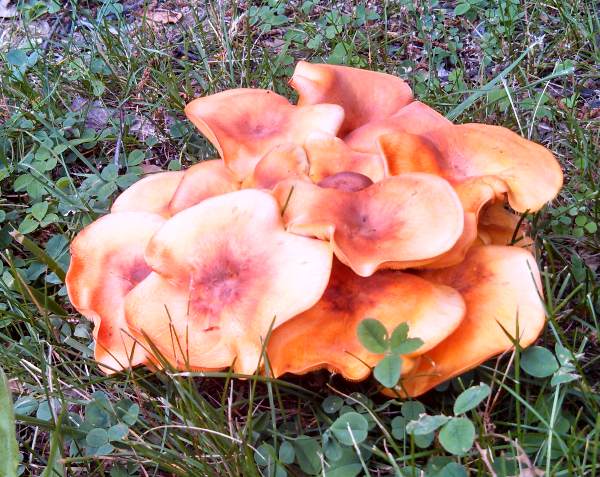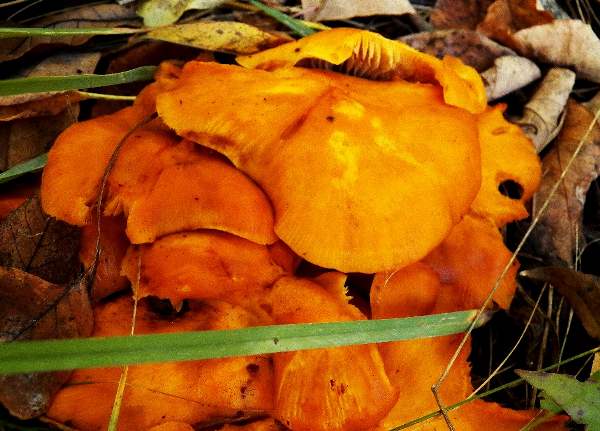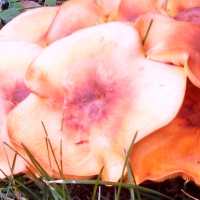Omphalotus illudens (Schwein.) Bresinsky & Besl - Jack o' Lantern
Phylum: Basidiomycota - Class: Agaricomycetes - Order: Agaricales - Family: Marasmiaceae
Distribution - Taxonomic History - Etymology - Identification - Toxicity - Reference Sources

Jack o' Lantern is a striking, bright orange mushroom that usually grows in dense tufts from the decaying underground roots of deciduous trees or from dead stumps and, less commonly fallen branches. It's dual claim to fame is that it is a poisonous mushroom whose gills are (weakly!) bioluminescent. (A few gilled mushrooms and several other kinds of fungi are known to emit light. In a very dark environment, when your eyes have had time to adjust, the gills of Jack o' Lantern can sometimes be seen glowing a ghostly green.)

Pictures on this page were taken in Pennsylvania by Dan Moore, with whose permission they are shown.
Distribution
In Britain this is a very rare species, and according to the British Mycological Society's Checklist of Fungi of the British Isles only about 20 official records have been authenticated, all in southeast England. (The conservation status of Omphalotus illudens is Near Threatened on the 2006 Red Data List authored by Shelly Evans et al.) This species is also found in many parts of central and southern mainland Europe and in of North America, where according to mushroom expert Michael Kuo this species is common east of the Rocky Mountains.
Taxonomic history
This saprobic mushroom was described in 1822 by American botanist-mycologist Lewis David von Schweinitz (1780 - 1834), who gave it the binomial scientific name Agaricus illudens. (Most gilled fungi were initially placed in a giant Agaricus genus, now redistributed to many other genera.) The currently accepted scientific name Omphalotus illudens dates from a 1979 publication in Sydowia 8: 106 by mycologists Andreas Bresinsky (born 1935) and Helmut Besl, both of Regensburg University, Germany.
In Britain this mushroom has been incorrectly referred to as Omphalotus olearius, but that name belongs to a closely-related species that has not been confirmed as occurring in Britain. Valid synonyms of Omphalotus illudens include Agaricus illudens Schwein., and Clitocybe illudens (Schwein.) Sacc.
Etymology
The genus name Omphalotus means umbilicate (in the form of a navel), and refers to the central depression in mature caps, as seen in the picture above, while the specific epithet illudens means 'deceiving'. Whether the latter is a reference to the fact that many people have been deceived into eating these toxic toadstools in the mistaken belief that they are Chanterelles remains unclear. (Omphalotus illudens is more easily confused with the deceptively similar Omphalotus olearius, which occurs nearly always with olive trees in southern Europe.)
Toxicity
Jack o' Lantern and other members of the genus Omphalotus are seriously poisonous toadstools that contain the toxin muscarine; when eaten they cause gastric upsets that can last for several days. Poisoning by this species is not usually fatal, but great care must be taken when gathering edible orange-coloured mushrooms such as Chanterelles to avoid accidentally including Jack o' Lantern. (Even more dangerous is the superficially similar Cortinarius rubellus, which has been responsible for many deaths.)
Identification guide
 |
Cap7 to 20cm across; initially convex with an inrolled margin, flattening and eventually developing an upturned wavy margin; smooth; bright orange to yellowish orange. |
GillsDecurrent; non-forking; colour as cap. Stem5 to 20cm long and 1 to 2cm diameter, smooth, tapering towards the base; yellowish orange, darkening towards the base. |
|
SporesEllipsoidal to globose, smooth, 3.5-5 x 3.5-5µm. Spore printCreamy white. |
|
Odour/taste |
Odour quite strong but pleasant; taste not distinctive. |
Habitat & Ecological role |
Saprobic, on buried decaying hardwood roots, especially oaks and Sweet Chestnut, often in lawns and park grassland near to trees; also occasionally on hardwood stumps. |
Season |
July to October in Britain; through to late November in parts of North America |
Similar species |
Hygrophoropsis aurantiaca has forked gills and does not form caespitose clusters. |
Reference Sources
Fascinated by Fungi, 2nd Edition, Pat O'Reilly 2016, reprinted by Coch-y-bonddu Books in 2022.
Dictionary of the Fungi; Paul M. Kirk, Paul F. Cannon, David W. Minter and J. A. Stalpers; CABI, 2008
Taxonomic history and synonym information on these pages is drawn from many sources but in particular from the British Mycological Society's GB Checklist of Fungi.
Acknowledgements
This page includes pictures kindly contributed by Dan Moore and Nigel Kent.
Fascinated by Fungi. Back by popular demand, Pat O'Reilly's best-selling 450-page hardback book is available now. The latest second edition was republished with a sparkling new cover design in September 2022 by Coch-y-Bonddu Books. Full details and copies are available from the publisher's online bookshop...

